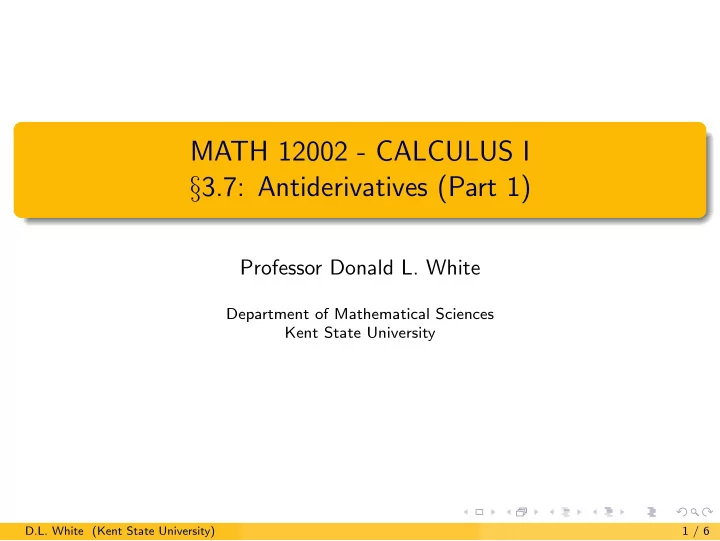

MATH 12002 - CALCULUS I § 3.7: Antiderivatives (Part 1) Professor Donald L. White Department of Mathematical Sciences Kent State University D.L. White (Kent State University) 1 / 6
Definitions and Theorems Definition Let f be a function defined on an interval I . An antiderivative of f is a function F such that F ′ ( x ) = f ( x ) for all x in I . For example, if f ( x ) = 3 x 2 , then an antiderivative for f is F ( x ) = x 3 . But so are x 3 + 5, x 3 − 17, and x 3 + 78 . 34. Since the derivative of a constant is 0, x 3 + C is an antiderivative of 3 x 2 for any constant C . D.L. White (Kent State University) 2 / 6
Definitions and Theorems Recall one of the consequences of the Mean Value Theorem: Theorem If F ( x ) , G ( x ) are functions such that F ′ ( x ) = G ′ ( x ) on an interval I, then G ( x ) = F ( x ) + C on I for some constant C; that is, F and G differ only by a constant on I. In other words, every antiderivative of 3 x 2 is x 3 + C for some constant C . In general, we have Theorem If F is an antiderivative of f , then the general antiderivative of f is F ( x ) + C for an arbitrary constant C; that is, every antiderivative of f is of the form F ( x ) + C for some constant C. D.L. White (Kent State University) 3 / 6
Formulas Reversing any differentiation formula gives an antidifferentiation formula. For example, since d dx x m = mx m − 1 , it follows that the general antiderivative of f ( x ) = x n (for n � = − 1) is 1 n + 1 x n +1 + C . F ( x ) = Examples: The general antiderivative of f ( x ) = x 5 is F ( x ) = 1 6 x 6 + C . The general antiderivative of f ( x ) = x − 3 is F ( x ) = − 1 2 x − 2 + C . The general antiderivative of f ( x ) = √ x = x 1 / 2 is F ( x ) = 2 3 x 3 / 2 + C . x 7 = x − 7 is F ( x ) = − 1 6 x − 6 + C . The general antiderivative of f ( x ) = 1 D.L. White (Kent State University) 4 / 6
Formulas Other basic antidifferentiation formulas are the following (with F ′ = f and G ′ = g , and k a constant): Function Antiderivative x n ( n � = − 1) n +1 x n +1 + C 1 sin x − cos x + C cos x sin x + C kf ( x ) kF ( x ) + C f ( x ) + g ( x ) F ( x ) + G ( x ) + C From our differentiation formulas, we also know that the general antiderivative of sec 2 x is tan x + C and the general antiderivative of sec x tan x is sec x + C . Note that F ( x ) G ( x ) + C is not the antiderivative of f ( x ) g ( x ) and F ( x ) G ( x ) + C is not the antiderivative of f ( x ) g ( x ) . D.L. White (Kent State University) 5 / 6
Examples 1 The general antiderivative of f ( x ) = 3 x 4 + sin x − 5 is � 1 5 x 5 � F ( x ) = 3 + ( − cos x ) − 5 x + C 5 x 5 − cos x − 5 x + C . 3 = 2 The general antiderivative of f ( x ) = ( x 2 + 5)(2 x + 7) = 2 x 3 + 7 x 2 + 10 x + 35 is 4 x 4 + 7 3 x 3 + 10 2 x 2 + 35 x + C 2 F ( x ) = 2 x 4 + 7 3 x 3 + 5 x 2 + 35 x + C . 1 = 3 x 3 + 5 x )( x 2 + 7 x ) + C .) (Note that this is not ( 1 D.L. White (Kent State University) 6 / 6
Recommend
More recommend